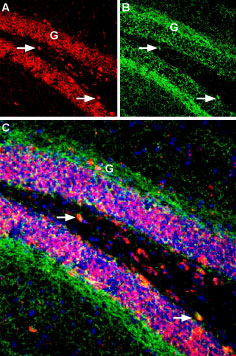Overview
- Peptide (C)SPRVLFSTQPPPTSSDTLDLD, corresponding to amino acid residues 84-104 of rat NGF (precursor) (Accession P25427). Pro-domain of the NGF protein.

 Western blot analysis of 100 ng Recombinant mouse proNGF protein (#N-250) (lanes 1 and 3) and Recombinant human proNGF protein (#N-280) (lanes 2 and 4):1-2. Guinea pig Anti-proNGF Antibody (#ANT-005-GP), (1:200).
Western blot analysis of 100 ng Recombinant mouse proNGF protein (#N-250) (lanes 1 and 3) and Recombinant human proNGF protein (#N-280) (lanes 2 and 4):1-2. Guinea pig Anti-proNGF Antibody (#ANT-005-GP), (1:200).
3-4. Guinea pig Anti-proNGF Antibody, preincubated with the blocking peptide.
 Expression of proNGF in mouse cortexImmunohistochemical staining of perfusion-fixed mouse brain frozen sections using Guinea pig Anti-proNGF Antibody (#ANT-005-GP), (1:400), followed by goat-anti-guinea pig-Cy3. proNGF staining (red) appears in the pyramidal layer (arrows). Nuclei were stained with DAPI (blue).
Expression of proNGF in mouse cortexImmunohistochemical staining of perfusion-fixed mouse brain frozen sections using Guinea pig Anti-proNGF Antibody (#ANT-005-GP), (1:400), followed by goat-anti-guinea pig-Cy3. proNGF staining (red) appears in the pyramidal layer (arrows). Nuclei were stained with DAPI (blue).
- Lessman, V. et al. (2003) Prog. Neurobiol. 69, 341.
- Bibel, M. et al. et al. (2000) Genes Dev. 14, 2929.
- Lee, R. et al. (2001) Science 294, 1945.
- Ibanez, C.F. (2002) Trends Neurosci. 25, 284.
- Hasan, W. et al. (2003) J. Neurobiol. 57, 38.
- Beattie, M.S. et al. (2002) Neuron 36, 375.
- Fahnestock, M. et al. (2001) Mol. Cell. Neurosci. 18, 210.
- Lu, B. (2003) Neuron 39, 735.
Neurotrophins are synthesized as pro-forms that can be cleaved either intracellularly to release mature, secreted ligands, or extracellularly by various proteases such as plasmin, furin, PC1/3, PC7, and PACE 4.1,2,5 The immature precursor has a prodomain of 103 amino acids, which was thought to have a role in the folding and sorting of the mature NGF into the various secretion pathways.
It was recently reported that proNGF, binds p75NTR receptor preferentially over TrkA, and this selective binding of proNGF to p75NTR leads to apoptotic death of cells that express both TrkA and p75NTR. However, mature NGF binds and activates both receptors, with resulting promotion of cell survival due to the TrkA-mediated survival signal overriding p75NTR -mediated apoptotic signal.3,4
Since pro- and mature neurotrophins seem to elicit opposite functional effects, by differential interactions with Trks and p75NTR receptors, extracellular cleavage represents a new way to control the synaptic functions of neurotrophins.
It was demonstrated that proNGF from injured spinal cord extracts, is active and induce apoptosis among oligodendrocytes, and apoptosis can be blocked by a proNGF-specific antibody.6
Finally, proNGF was demonstrated as the predominant form in mouse, rat, and human brain tissue, thyroid, hippocampus, thus suggesting a role for proNGF in vivo.5,7,8
Application key:
Species reactivity key:
Alomone Labs is pleased to offer a highly specific antibody directed against rat proNGF. Guinea pig Anti-proNGF Antibody (#ANT-005-GP, formerly AGP-031) can be used in western blot and immunohistochemistry applications. Anti-proNGF Antibody raised in guinea pig recognizes the same epitope as Anti-proNGF Antibody (#ANT-005) raised in rabbit. The antibody specifically reacts with proNGF and does not crossreact with proBDNF, proNT-3 or mature NGF. It has been designed to recognize proNGF from mouse, rat and human samples. Our line of guinea pig antibodies enables more flexibility with our products such as multiplex staining studies, immunoprecipitation, etc.
Related products for neutralizing proNGF activity:
Mouse NGF/proNGF Neutralizing Antibody (#ALM-006) can be used in indirect ELISA and neutralization assays to block the biological effects of both NGF and proNGF.
 Multiplex staining of proNGF and Cannabinoid Receptor 1 in mouse hippocampal dentate gyrusImmunohistochemical staining of immersion-fixed, free floating mouse brain frozen sections using Guinea pig Anti-proNGF Antibody (#ANT-005-GP), (1:300) and rabbit Anti-Cannabinoid Receptor 1 (extracellular) Antibody (#ACR-001), (1:300). A. proNGF staining (red) appears in the dentate gyrus (DG) granule layer (G) and in hilar interneurons (arrows). B. CB1R staining (green) appears in axonal processes surrounding the granule layer and a few hilar interneurons (arrows). C. Merge of the two images reveals co-localization of proNGF and CB1R in a few hilar cells. Cell nuclei were stained with DAPI (blue).
Multiplex staining of proNGF and Cannabinoid Receptor 1 in mouse hippocampal dentate gyrusImmunohistochemical staining of immersion-fixed, free floating mouse brain frozen sections using Guinea pig Anti-proNGF Antibody (#ANT-005-GP), (1:300) and rabbit Anti-Cannabinoid Receptor 1 (extracellular) Antibody (#ACR-001), (1:300). A. proNGF staining (red) appears in the dentate gyrus (DG) granule layer (G) and in hilar interneurons (arrows). B. CB1R staining (green) appears in axonal processes surrounding the granule layer and a few hilar interneurons (arrows). C. Merge of the two images reveals co-localization of proNGF and CB1R in a few hilar cells. Cell nuclei were stained with DAPI (blue).
